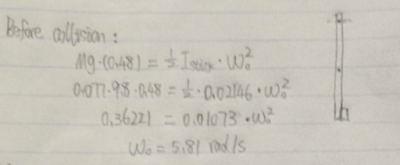Lab 19
Purpose: By using conservation of Energy and conservation of angular momentum to test how high a meter stick and clay will go after they stick together.
Apparatus:
1. One meter stick and sticky clay with some mass.2. Laptop with video capture option.
3. A Holder can fix the meter stick.
4. Fix the top as pivot.
Steps:
1.Measure the mass of meter stick, and clay mass.2.Set up the equipment, and start to capture the process.
1).Set the meter stick to horizontal position and let it go.
2).Meter stick and clay stick together when it reach the bottom of swing and collides in elastically.
3).Reach and rotate together at some height.
4).Find the height by using laptop and video capture.
Prediction:
To compare our results accuracy, it can be shown by assuming energy and angular momentum are conserved during the whole process.
First scene: meter stick with gravitational energy exchange to angular velocity at bottom of swing and hit the clay with inelastic collision.
Because the meter stick is swing and rotating, so we have to find out the momentum of inertia of the meter stick as pivot at top
By knowing how height the meter stick is and mass of them, using conversation of energy to find the angular velocity of meter stick at bottom.
(Note: Meter stick is not one small ball, so center mass of meter stick should at middle. To find the velocity should be 2mg/h = 1/2*Iw^2
Then using conversation of angular momentum find out the velocity after collision which by the way is IstickW = Itotal*Wf
Second scene: Meter stick and clay stick together and go some height and stop.
After collision, using conversation of energy again. Angular velocity of the meter stick and clay exchange to the gravitational energy.
(Note: the moment of inertia is not the one before, it's a new because this time it has clay on it.)
And find the how height they went together.
Comparing the two results.
Example:
1)The mass of meter stick and clay, and length of meter stick.
2)video capture and result of height at laptop.
Which gives H = 0.279m
(Note: the length of stick is not 1 meter because the hole at the top is not exact. so may set the meter lenght to 0.98 m)
3)Prediction
- moment of inertia of stick
It gives angular velocity of stick at bottom is 5.81 rad/s
- After collision
It gives angular velocity of stick and clay at bottom is 2.6499 rad/s
- Uncertainty.
Conclusion:
This lab is to use the energy and angular momentum conserved to find out the height of meter stick and clay go up. To check out prediction result, we set up a experiment and find the height in experiment, then compare those two results gives uncertainty is 0.44 % off.
Source of uncertainty:
This lab is to use the energy and angular momentum conserved to find out the height of meter stick and clay go up. To check out prediction result, we set up a experiment and find the height in experiment, then compare those two results gives uncertainty is 0.44 % off.
Source of uncertainty:
- in the experiment, when the meter stick and clay stick together may lose energy.
- Air resistance will cause some energy lose.
- The original position when release the meter stick may not accurate.








没有评论:
发表评论